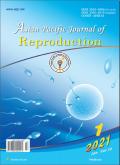Pregnancy outcomes following supplementation of single dose GnRH agonist to sustain the luteal phase in antagonist fresh embryo transfer cycles: A multicentric prospective cohort study
IF 0.6
Q4 REPRODUCTIVE BIOLOGY
引用次数: 0
Abstract
Objective: To determine whether a single dose of gonadotropin-releasing hormone (GnRH) agonist administered subcutaneously in addition to the regular progesterone supplementation could provide a better luteal support in antagonist protocol fresh embryo transfer cycles. Methods: This prospective, multicentric, cohort study included total 140 women, 70 in each group. Controlled ovarian stimulation was carried out as per fixed GnRH antagonist protocol. The trigger was given with hCG. In vitro fertilization/intracytoplasmic sperm injection (IVF/ICSI) was performed and day-3 embryos were transferred. Patients were divided into groups 1 and 2 based on computer generated randomization sheet. Six days following oocyte retrieval, group 1 received 0.2 mg decapeptyl subcutaneously in addition to regular progesterone support while group 2 received progesterone only. Luteal support was given for 14 days to both groups; if pregnancy was confirmed luteal support was continued till 12 weeks of gestation. The clinical pregnancy rate was the primary outcome. The implantation rate, miscarriage rate, live birth delivery rate, and multiple pregnancy rates were the secondary outcomes. Results: A total of 140 patients were analysed, 70 in each group. Clinical pregnancy rates (47.1% vs. 35.7%; P=0.17), implantation rates (23.4% vs. 18.1%, P=0.24), live birth delivery rates (41.4% vs. 27.1%, P=0.08), and multiple pregnancy rates (21.2% vs. 16.0%, P=0.74) were higher in group 1 than in group 2. Group 1 had a lower miscarriage rate than group 2 (5.7% vs. 8.6%; P=0.75). However, these differences were not statistically significant between the two groups. Conclusions: Administration of a single dose of GnRH agonist in addition to regular natural micronized vaginal progesterone as luteal support in GnRH antagonist protocol cycles marginally improves implantation rates, clinical pregnancy rates, and live birth delivery rates. However, more studies with higher sample sizes are needed before any conclusive statements about GnRH agonist as luteal phase support can be made.在拮抗剂新鲜胚胎移植周期中补充单剂量GnRH激动剂以维持黄体期后的妊娠结局:一项多中心前瞻性队列研究
目的:探讨单剂量促性腺激素释放激素(GnRH)激动剂在常规黄体酮补充的基础上皮下注射是否能在拮抗剂方案的新鲜胚胎移植周期中提供更好的黄体支持。方法:这项前瞻性、多中心、队列研究共纳入140名女性,每组70名。对照卵巢刺激按照固定GnRH拮抗剂方案进行。触发剂是hCG。进行体外受精/胞浆内单精子注射(IVF/ICSI),移植第3天的胚胎。根据计算机生成的随机分组表将患者分为1组和2组。取卵6天后,组1在常规黄体酮支持的基础上皮下注射十肽0.2 mg,组2只注射黄体酮。两组均给予黄体支持14 d;如果确认怀孕,黄体支持持续到妊娠12周。临床妊娠率为主要观察指标。次要指标为着床率、流产率、活产率和多胎妊娠率。结果:共分析140例患者,每组70例。临床妊娠率(47.1% vs. 35.7%;P=0.17)、着床率(23.4% vs. 18.1%, P=0.24)、活产率(41.4% vs. 27.1%, P=0.08)、多胎妊娠率(21.2% vs. 16.0%, P=0.74)均高于组2。1组流产率低于2组(5.7%比8.6%;P = 0.75)。然而,这些差异在两组之间没有统计学意义。结论:在GnRH拮抗剂方案周期中,单剂量GnRH激动剂加常规天然微粉阴道孕酮作为黄体支持剂,可略微提高着床率、临床妊娠率和活产率。然而,在任何关于GnRH激动剂作为黄体期支持剂的结论性声明之前,需要更多样本量更大的研究。
本文章由计算机程序翻译,如有差异,请以英文原文为准。
求助全文
约1分钟内获得全文
求助全文
来源期刊

Asian Pacific Journal of Reproduction
Veterinary-Veterinary (all)
CiteScore
1.70
自引率
0.00%
发文量
588
审稿时长
9 weeks
期刊介绍:
The journal will cover technical and clinical studies related to health, ethical and social issues in field of Gynecology and Obstetrics. Articles with clinical interest and implications will be given preference.
 求助内容:
求助内容: 应助结果提醒方式:
应助结果提醒方式:


